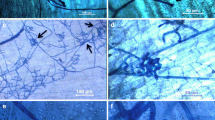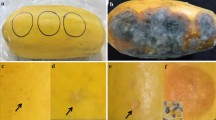Summary
Preliminary data concerning histological distribution of late blight necroses in artificially and/or naturaily infected tubers are reported. A preferential localization of necroses in the pith and cortex was found in susceptible as well as in resistant varieties. In an incipient stage of infection, the necroses were located only in one or in the both tissues depending on the way of parasite entrance into the tuber. The vascular ring seems temporarily to stop necrosis extension to the tuber centre.
Zusammenfassung
Es wird über Versuchsergebnisse berichtet, die sich auf den bestehenden Zusammenhang zwischen der Verteilung von Knollenfäule-Nekrosen (Phytophthora infestans) in der Knolle und der anatomischen Struktur der Knolle beziehen. Künstlich infizierte Knollen (Bintje und Braşovean) zeigten ein bevorzugtes Auftreten von Nekrosen im Mark und in der Rinde (Abb. 1a, 1b, 2 und 4). Durch die Markstrahlen (abb. 3) erreichte der Parasit die Augen (Triebe), wenn das Fleisch inokuliert wurde, oder die Knollenmitte, wenn der Parasit durch die Augen eindrang. Die tatsächliche Häufigkeit der bevorzugten Lokalisierung, das heisst die bei kontrollierten Knollen (Knollen, in denen andere Mikro-organismen fehlten) errechnete Häufigkeit, zeigte, dass dieses Phänomen allgemein verbreitet war (Tabellen 1 und 2).
Die gleiche Erscheinung war auch vorherrschend in natürlicherweise infizierten Knollen sowohl der Sorten Bintje, Désirée, Katahdin (Abb. 5a, b; 6a, b; 7 und Tabellen 3, 4, 5) als auch von Ostara, Braşovean, Merkur, Spartaan, Eba und unterschiedlichen Genotypen. Sortenunterschiede zeigten sich, wenn die Ausbreitungsgeschwindigkeit der Nekrosen in Mark und Rinde bei künstlich infizierten Knollen von Ostara, Braşovean und Bintje untersucht wurde.
Die bevorzugte Lokalisierung von Nekrosen in den beiden Geweben könnte mit gewissen Besonderheiten bezüglich ihrer Anatomie und chemischen Zusammensetzung verbunden sein; aber sie scheint auch ein Ergebnis der zeitweisen Beschränkung der Ausdehnung von Nekrosen durch die Gefässbündelstränge zu sein. Im Anfangsstadium der Infektion wurden die Nekrosen nur im Mark und/oder in der Rinde festgestellt, je nach dem Weg auf dem der Parasit eindringt. In einem fortgeschrittenen Stadium der Infektion waren die Nekrosen in der Regel im perimedullaren Parenchym weniger dicht verbreitet.
Auf Grund der Kenntnis der histologischen Verteilung der Nekrosen im Innern der Knolle könnten die Methoden der Resistenzprüfung verbessert werden.
Résumé
Des données préliminaires sont obtenues sur la relation existant entre la répartition des nécroses de mildiou dans le tubercule et la structure anatomique de celui-ci. Lorsqu'ils sont artificiellement infectés, les tubercules (var. Bintje et Braşovean) montrent une localisation préférentielle de nécroses dans la moëlle et le cortex (fig. 1a, 1b, 2 et 4). Quand la chair est inoculée, le parasite atteint les yeux par les rayons médullaires (fig. 3), ou le centre du tubercule quand il pénètre par les yeux. La fréquence réelle de la localisation préférentielle, à savoir la fréquence calculée sur les tubercules pris en considération — tubercules indemnes de tout autre microorganisme — montre que le phénomène est prédominant (tableaux 1 et 2).
Le même phénomène prédomine égalen ent dans les tubercules, infectés naturellement, des variétés Bintje, Désirée, Katahdin (fig. 5a, b; 6a, b; 7 et tableaux 3, 4, 5), aussi bien que des variétés Ostara, Braşovean, Merkur, Spartaan, Eba et d'autres génotypes. Des différences variétales apparaissent quand les degrés d'extension des nécroses sont établis sur Ostara, Braşovean et Bintje, infectées artificiellement. la localisation préférentielle des nécroses dans les deux tissus peut être liée à certaines particularités anatomiques et à leur composition chimique mais paraît aussi résulter d'une limitation temporaire des nécroses par les tissus vasculaires. Dans la phase naissante de l'infection, les nécroses sont localisées seulement dans la moëlle ou le cortex selon la voie de pénétration du parasite. A un stade avancé d'infection, les nécroses sont régulièrement moins concentrées dans le parenchyme périmédullaire.
On peut améliorer les méthodes de test de résistance à partir de ces données de répartition histologique des nécroses dans le tubercule.
Similar content being viewed by others
References
Agrios, G. N., 1969. Plant pathology. Academic Press, New York and London, pp. 239–247.
Anonymous, 1972. 47e rassenlijst voor landbouwgewassen. Instituut voor Rassenonderzoek van Landbouwgewassen (IVRO), Wageningen pp. 231–235.
Babilas, W., 1969. (Examinarea metodelor de avertizare a momentului combaterii manei în plantatiile de cartof.)Ochr. Roslin 10: 8–10.
Baijal, B. D. & W. F. van Vliet, 1966. The chemical composition in different parts of the potato tuber during storage.Eur. Potato J. 9: 179–192.
Bary, A. de, 1887. Comparative morphology and biology of the fungi, mycetozoa and bacteria. Clarendon Press, Oxford, reprinting 1966 by Johnson Reprint Corporation, New York, p. 392.
Burton, W. G., 1966. The potato. Veenman, Wageningen, Netherlands, pp. 143, 152, 211–217.
Callbeck, L. C., 1968. Late blight of potatoes and its control. Publication 837, Canada Department of Agriculture.
Červenka, J., 1962. (Überwinterung und Herkunft der primären Kraut- und Knollenfäule der Kartoffel (Phytophthora infestans Mont. de Bary.)Sbornik CSAZV Rost. vyroba 8: 131–138.
Cupşa, I. & B. Plamadeala, 1970. Stabilirea rezistentei relative a tuberculilor de cartof la atacul ciuperciiPhytophthora infestans (Mont.) de By în conditiii de laborator.Anal. I.C.C.S. Cartoful, 2: 77–89.
Fehrmann, H., 1963. Untersuchungen zur Pathogenese der durchPhytophthora infestans hervorgerufenen Braunfäule der Kartoffelknolle.Phytopath. Z. 46: 371–405.
Fehrmann, H. & E. A. Dimond, 1967. Peroxidase activity andPhytophthora resistance in different organs of the potato plant.Phytopathology 57(1): 69–72.
Fehrmann, H., 1971. Obligater Parasitismus phytopathogener Pilze. I. Vergleichende Wachstumsversuche mitPhytophthora infestans und verwandten Arten.Phytopath. Z. 70: 89–113.
Hulea, Ana, 1967. Mana cartofului şi combaterea ei. Centrul de documentare agricola, Bucureşti, p. 14.
Johnston, F. B., I. Hoffmann & A. Petrasovits, 1968. Distribution of mineral constituents and dry matter in the potato tuber.Am. Potato J. 45: 287–292.
Kaiho, Mäkelä, 1966. Factors influencing the epidemics ofPhytophthora infestans (Mont.) de Bary in Finland.Suom. maatal. Seur. Julk. (Acta agral. fenn. Helsinki) 104 (2): 34.
Knee, M., 1970. The use of a new, rapid micro-method for analysing changes in the carbohydrate fractions of potato tuber tissue after invasion byPhytophthora infestans.Phytochemistry 9(10): 2075–2083.
Lacey, J., 1965. Infectivity of soils containingPhytophthora infestans spores.Ann. appl. Biol. 56(3): 363–380.
Lacey, J., 1967. Susceptibility of potato tubers to infection byPhythophthora infestans.Ann. appl. Biol. 59: 257–264.
Lapwood, D. H., 1961. Haulm and tuber resistance toPhytophthora infestans.Rep. rothamst. Exp. Stn 1960: 123–124.
Lapwood, D. H., 1965. Laboratory assessments of the susceptibility of potato tuber tissue to blight (Phytophthora infestans).Eur. Potato J. 8: 215–229.
Lapwood, D. H., 1967. Laboratory assessments of the susceptibility of potato tubers to infection by blight (Phytophthora infestans).Eur. Potato J. 10: 127–135.
Lin Chwan-Kwang, Hwang Ho, Wang Tao-Peng & Hwo Suo Hsiang, 1967. Observations on the formation of primary foci of late blight in potato plantation.Acta phytopath. sinica 3(1): 19–28.
Naumova N. A., 1961.Phytophthora Kartofelea.Selhozghiz, Moskva (pp. 9, 23, 61 in the Rumanian translation).
Radulescu, E., 1969. Tratat de fitopatologie agricola, Vol. 2. Ed. Acad. RSR Bucureşti, pp. 348.
Reeve, R. M., E. Hautala, M. L. Weaver, 1969. Anatomy and compositional variation within potatoes. I. Developmental histology of the tuber; II. Phenolics, enzymes and other minor components.Am. Potato J. 46: 361–386.
Reeve, R. M., E. Hautala & M. L. Weaver, 1970. Anatomy and compositional variation within potatoes. III. Gross compositional gradients.Am. Potato J. 47: 148–162.
Schick, R., M. Klinkowski, 1961. Die Kartoffel. VEB Deutscher Landwirtschaftsverlag, Berlin, Band I: 19–44.
Wenzl, V. H., 1967. Histologische Studien über Befall durchPhytophthora infestans an Kartoffelstengeln.Z. PflKrankh. PflSchutz 74(9) 533–539.
Whitehead, T., T. P. McIntosh & W. M. Findlay, 1953. The potato in health and disease, 3rd ed. Oliver and Boyd, Edinburgh, pp. 334–351.
Zaag, D. E. van der, 1956. Overwintering and epidemiology ofPhytophthora infestans, and some new possibilities of control. Veenman, Wageningen, pp. 24, 59–65.
Author information
Authors and Affiliations
Rights and permissions
About this article
Cite this article
Cupsa, I. The distribution in potato tubers of necroses caused byPhytophthora infestans: preliminary communication. Potato Res 17, 34–50 (1974). https://doi.org/10.1007/BF02361868
Accepted:
Issue Date:
DOI: https://doi.org/10.1007/BF02361868




